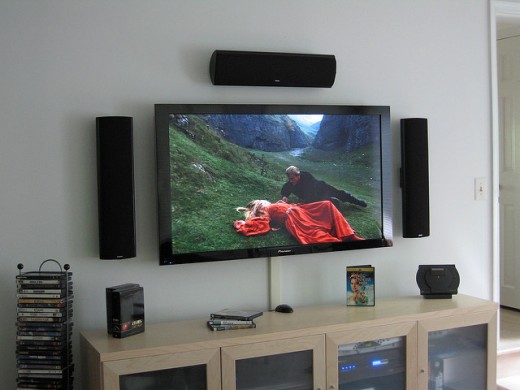Finding the Best Plasma TV

Looking for the Best Plasma TV?
Plasma televisions have been around for a quite a number of years now. The technology continues to improve and these sets offer a number of advantages that have caused them to surge in popularity recently. If you are now on the hunt for the best plasma TV, then this page should help you.
Here you can learn just a bit about what advantages plasma displays offer and get some help for choosing one if you are a beginner.
About Plasma TV
Plasma televisions are known for their great color, deep blacks, and high contrast. They offer wide viewing angles (160 degrees) and present very smooth fast motion. They are perfect for gaming, sports, and action scenes in movies and TV shows.
A modern plasma screen offers a long life and greater energy efficiency too. With 3D viewing becoming more popular, plasma TVs are regaining their popularity as the best display for this three dimensional viewing.
Plasma TV displays look best in low light. Many of them however have added anti-glare screens and filters to cut down reflective light and some also have sensors to automatically adjust brightness based on room conditions to assure the best picture in any condition.
Plasma TVs also offer a longer life than was once true. Manufacturers now tout 60,000 to 100,000 hour life. Plasma TVs do consume more energy than an LCD model, but strides are being made to cut this significantly.
Terms to Know
If you will be buying your first plasma TV, there are some terms you may encounter which manufacturers and sales people may use. Here are a few basics you should know.
Contrast Ratio
Contrast ratio is basically the difference between the lightest and darkest colors that a panel can display simultaneously. So a number like 1,000,000:1 is very good but a number like 5,000,000:1 is better. Plasma displays are known for their great contrast ratio, their deep blacks. The numbers can become astronomical, but for many viewers, contrast of 5,000,000:1 doesn't look significantly different from 20,000,000:1. Individual buyers will have to determine their preference based on their budget and what they see on the screen.
Sub-Field Rate
As a shopper you will see references to sub-field rate, sub-field motion, and refresh rate. Refresh rate is actually a term better associated with LCD TVs which use a different process/technology, but it is similar in it's effect when applied to Plasma TVs. They both relate to the smoothness of the motion you see on the screen.
In the case of plasma TVs, the smoothness of motion relates to how fast the pixels fire or are lit up. To see motion, a TV displays a series of still images that convinces your eyes and brain to perceive motion. Faster frame rates create smoother motion. Because the pixels of a Plasma TV light only very briefly, the sub-field drive must excite them electrically, causing them to flash, multiple times per frame. Typically a plasma TV will have a 60 frames per second rate and, if the subfield drive excites the pixels 10x/frame, then the sub-field motion will be said to be 600Hz. The difference between say 480Hz and 600Hz may be noticeable only during fast action sequences.
Response Time
Plasma TVs have rapid response time. This is the time between when a pixel is on (illuminated) and off. A fast response time assures a quick transition between images.
Viewing Angle
Many plasma TVs report 160 degree viewing angles. This is a wide viewing angle. Obviously, when viewers sit directly in front of a screen there is no distortion. If they move off to the side of center, there may be increasing distortion. The viewing angle indicates how far off center viewers can sit while still enjoying a good view. When watching 3D programming, viewing angles can be more restricted.
How to Choose the Best Plasma TV
Buying the best plasma TV means choosing the one that has the features you want and the specifications that are right for your needs. Here are a few of the basics you need to consider:
Size
Sitting close to a high definition screen generally doesn't distort the picture so choosing the right size is mostly a matter of personal preference. Most plasma TVs are 42" or larger. In general, if there will be less than 15 feet between the viewers and the TV screen, a display that is 50" or less is recommended. If the distance is 15 feet or greater, the 60" and larger screens are considered acceptable.
Connections
Today's televisions generally end up with a variety of devices connected to them. Set top boxes, Blu-Ray players, gaming consoles, and so forth. In addition, you may want connections for a keyboard, a jump drive, or SD cards from your camera. The best plasma TV for you will have all of the connections you need and they will be located them where they are accessible. (For instance, ports on the side are often easier to access than ports on the back if you are connecting a device that isn't permanent.)
Resolution and Image Quality
Resolution determines the degree of detail in a picture. Resolution is measured in horizontal and vertical arrangement of pixels. A TV with 1920 x 1080 resolution has 1080 rows of lines from top to bottom on the screen and 1920 columns of lines from left to right. They can be displayed interlaced (1080i) or progressively (1080p). A screen displaying 1080p will generally look better. In addition, a 1080p display will look better than one with fewer lines such as 720p but if the display is small enough, less information is acceptable. Since most plasma displays are large however, 1080p is preferred.
Color accuracy and brightness tend to be great on these displays, but the best plamsa TV models often have anti-glare/anti-reflective features and/or sensors that automatically brighten or dim the screen based on the color of the walls and overall lighting in the room at a given time. A set that allows you to easily calibrate it are also a plus for an optimal picture.
As mentioned above, 600Hz subfield drive is desirable for the best performance during fast motion to avoid any blurring or lag. This is pretty standard on a good plasma screen TV.
Sound
If you have a great high definition picture, your programming will be more enjoyable with equally high definition sound. Stereo speakers with 20Watt power or more are good but in a larger room or in home theater set ups, Surround Sound, bass enhancement, and so forth are preferrable. Listening is the ultimate test.
Other Features
If you want to be able to enjoy 3D channels, Blu-Ray discs, and so forth you need a 3D capable TV. Of course, you would also need 3D glasses, 3D programming, and a 3D Blu Ray player.
If you want access to online content like YouTube videos, Amazon on Demand, or Netflix, and so forth, then you need a TV with Wi-Fi and the ability to connect to your broadband connection. A QWERTY remote or the ability to easily connect a keyboard can expand your access to online information.
Gamers might also be interested in a gaming mode. Certainly becoming aquainted with the energy usage of the set, both in use and on standby is important when looking at ongoing costs. Some sets offer a number of energy saving features.
© 2011 Ruth Coffee








